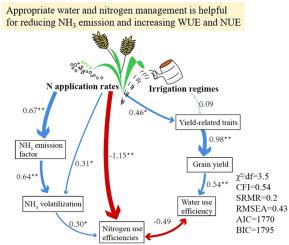Agricultural Water Management ( IF 6.7 ) Pub Date : 2021-07-01 , DOI: 10.1016/j.agwat.2021.107050 Xuejie Wan , Wei Wu , Yuncheng Liao

|
Agricultural ammonia (NH3) emissions significantly reduce nitrogen (N) use efficiency (NUE) and adversely affect environmental quality. There is thus much interest in mitigating NH3 emissions through appropriate N fertilizer and water management in winter wheat. A two–year field study –was conducted to quantify the recovery of 15N–labelled N fertilizer and to investigate the NH3 flux, grain yield, yield–scaled NH3 emissions, NUEs and water use efficiency (WUE) among different N application rates (0, 120, 240, and 360 kg N ha–1, abbreviated as N0, N120, N240 and N360, respectively) under rain–fed and supplemental irrigation condition. The peak daily NH3 emissions reached 2–8 DAS after basal N fertilizer application, and the fluxes decreased to relatively low levels thereafter. Most NH3 volatilization (> 90%) occurred within one month after sowing. The maximum accumulative NH3 emission was 66 kg N ha–1 in N360, which was increased by 104%, 2–fold and 12–fold compared with N240, N120 and N0, respectively, averaged across water regimes and experimental years. The NH3 emission factor (%) of N360 was significantly increased by 43% and 77% compared with the other two N application rates (N120 and N240) under rain–fed and supplemental irrigation regimes, respectively. Water regimes did not have a significant effect on NH3 fluxes or NH3 emission factors (%). Grain yield, WUE and yield–scaled NH3 emissions generally increased with increasing N application rate, and the highest values were achieved under N120 or N240 regardless of the water regimes. All NUE traits were reduced, and the 15N residue in the soil profiles increased with increasing N application rates under both water regimes. The results suggested that high NH3 emissions were the major reason for inferior NUE, which was further confirmed by the 15N stable isotope. Overall, the medium N rate (120–240 kg N ha–1) is the optimal rate for achieving a high yield of 8 t ha–1, as further increases in N rates fail to produce significantly higher yield, and even increase NH3 emissions, lead to the deterioration of WUE and NUE, and cause serious environmental costs.
中文翻译:

冬小麦补充灌溉和雨养条件下通过适当的氮管理减少氨挥发并提高氮利用效率
农业氨 (NH 3 ) 排放显着降低氮 (N) 使用效率 (NUE),并对环境质量产生不利影响。因此,在冬小麦中通过适当的氮肥和水管理来减少 NH 3排放引起了很大的兴趣。进行了为期两年的田间研究,以量化15 N 标记的氮肥的回收率,并调查不同施氮中 NH 3通量、粮食产量、产量比例的 NH 3排放、NUE 和水分利用效率 (WUE)率(0、120、240 和 360 kg N ha –1,分别缩写为 N0、N120、N240 和 N360)在雨养和补充灌溉条件下。每日峰值 NH 3施氮肥后排放量达到2-8 DAS,此后通量下降到相对较低的水平。大多数NH 3挥发(> 90%)发生在播种后1个月内。N360 中最大累积 NH 3排放量为 66 kg N ha –1,与 N240、N120 和 N0 相比,在不同水体和实验年份中平均分别增加了 104%、2 倍和 12 倍。与其他两种施氮量(N120 和 N240)相比,在雨养灌溉和补充灌溉制度下,N360的 NH 3排放因子(%)分别显着提高了 43% 和 77%。水情对 NH 3通量或 NH 3没有显着影响排放因子(%)。谷物产量、WUE 和按产量衡量的 NH 3排放量通常随着施氮量的增加而增加,并且无论水情如何,在 N120 或 N240 下都能达到最高值。所有 NUE 性状都降低,土壤剖面中的15 N 残留量随着施氮量的增加而增加。结果表明,高 NH 3排放是 NUE 较差的主要原因,15 N 稳定同位素进一步证实了这一点。总体而言,中等施氮量(120–240 kg N ha –1)是实现 8 t ha –1高产的最佳施肥量,随着氮率的进一步增加无法产生显着更高的产量,甚至会增加NH 3排放,导致WUE和NUE的恶化,并造成严重的环境成本。



























 京公网安备 11010802027423号
京公网安备 11010802027423号